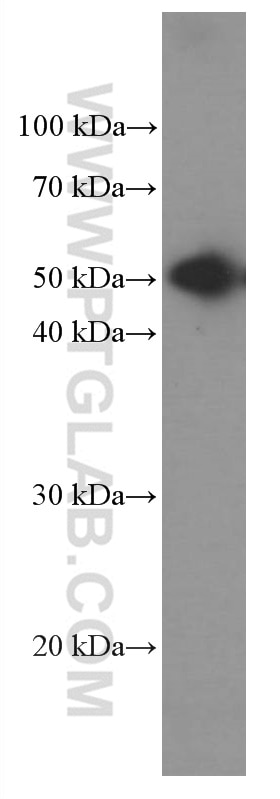Heavy chain of Rabbit IgG Monoklonaler Antikörper
Heavy chain of Rabbit IgG Monoklonal Antikörper für WB,ELISA
Wirt / Isotyp
Maus / IgG1
Getestete Reaktivität
Kaninchen und mehr (2)
Anwendung
WB, ELISA
Konjugation
Unkonjugiert
CloneNo.
1C9A5
Kat-Nr. : 66467-1-Ig
Synonyme
Galerie der Validierungsdaten
Geprüfte Anwendungen
| Erfolgreiche Detektion in WB | Kaninchen-Serumgewebe |
Empfohlene Verdünnung
| Anwendung | Verdünnung |
|---|---|
| Western Blot (WB) | WB : 1:1000-1:4000 |
| It is recommended that this reagent should be titrated in each testing system to obtain optimal results. | |
| Sample-dependent, check data in validation data gallery | |
Veröffentlichte Anwendungen
| WB | See 1 publications below |
Produktinformation
66467-1-Ig bindet in WB, ELISA Heavy chain of Rabbit IgG und zeigt Reaktivität mit Kaninchen
| Getestete Reaktivität | Kaninchen |
| In Publikationen genannte Reaktivität | human, Maus |
| Wirt / Isotyp | Maus / IgG1 |
| Klonalität | Monoklonal |
| Typ | Antikörper |
| Immunogen | Protein |
| Vollständiger Name | Heavy chain of Rabbit IgG |
| Beobachtetes Molekulargewicht | 50-55 kDa |
| Gene symbol | |
| Gene ID (NCBI) | |
| Konjugation | Unkonjugiert |
| Form | Liquid |
| Reinigungsmethode | Protein-G-Reinigung |
| Lagerungspuffer | PBS mit 0.02% Natriumazid und 50% Glycerin pH 7.3. |
| Lagerungsbedingungen | Bei -20°C lagern. Nach dem Versand ein Jahr lang stabil Aliquotieren ist bei -20oC Lagerung nicht notwendig. 20ul Größen enthalten 0,1% BSA. |
Hintergrundinformationen
This antibody specifically recognizes the heavy chain of Rabbit IgG.
Protokolle
| Produktspezifische Protokolle | |
|---|---|
| WB protocol for Heavy chain of Rabbit IgG antibody 66467-1-Ig | Protokoll herunterladen |
| Standard-Protokolle | |
|---|---|
| Klicken Sie hier, um unsere Standardprotokolle anzuzeigen |
Publikationen
| Species | Application | Title |
|---|---|---|
Oncol Lett Long non-coding RNA RNCR3 promotes glioma progression involving the Akt/GSK-3β pathway. | ||
Pharmacol Res RHBDF1 deficiency suppresses melanoma glycolysis and enhances efficacy of immunotherapy by facilitating glucose-6-phosphate isomerase degradation via TRIM32 |


